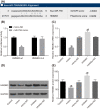Overexpression of miR-758 inhibited proliferation, migration, invasion, and promoted apoptosis of non-small cell lung cancer cells by negatively regulating HMGB
- PMID: 30446524
- PMCID: PMC6340954
- DOI: 10.1042/BSR20180855
Overexpression of miR-758 inhibited proliferation, migration, invasion, and promoted apoptosis of non-small cell lung cancer cells by negatively regulating HMGB
Abstract
Non-small cell lung cancer (NSCLC) is one of the most fatal types of cancer with significant mortality and morbidity worldwide. MicroRNAs (miRs) have been confirmed to have positive functions in NSCLC. In the present study, we try to explore the role of miR-758 in proliferation, migration, invasion, and apoptosis of NSCLC cells by regulating high-mobility group box (HMGB) 3 (HMGB3.) NSCLC and adjacent tissues were collected. Reverse transcription quantitative PCR (RT-qPCR) was employed to detect expression of miR-758 and HMGB3 in NSCLC and adjacent tissues, in BEAS-2B cells and NSCLC cell lines. The targetted relationship between miR-758 and HMGB3 was identified by dual luciferase reporter gene assay. The effects of miR-758 on proliferation, migration, invasion, cell cycle, and apoptosis of A549 cells. MiR-758 expression was lower in NSCLC tissues, which was opposite to HMGB3 expression. The results also demonstrated that miR-758 can target HMGB3. The cells transfected with miR-758 mimic had decreased HMGB3 expression, proliferation, migration, and invasion, with more arrested cells in G1 phase and increased apoptosis. Our results supported that the overexpression of miR-758 inhibits proliferation, migration, and invasion, and promotes apoptosis of NSCLC cells by negative regulating HMGB2. The present study may provide a novel target for NSCLC treatment.
Keywords: Apoptosis; HMGB3; Invasion; MicroRNA-758; Migration; Non-small cell lung cancer; Proliferation.
© 2019 The Author(s).
Conflict of interest statement
The authors declare that there are no competing interests associated with the manuscript.
Figures







Similar articles
-
The role of high mobility group protein B3 (HMGB3) in tumor proliferation and drug resistance.Mol Cell Biochem. 2021 Apr;476(4):1729-1739. doi: 10.1007/s11010-020-04015-y. Epub 2021 Jan 11. Mol Cell Biochem. 2021. PMID: 33428061 Review.
-
Effects of microRNA-513b on cell proliferation, apoptosis, invasion, and migration by targeting HMGB3 through regulation of mTOR signaling pathway in non-small-cell lung cancer.J Cell Physiol. 2019 Jul;234(7):10934-10941. doi: 10.1002/jcp.27921. Epub 2019 Jan 8. J Cell Physiol. 2019. PMID: 30623409
-
CircRNA_102179 promotes the proliferation, migration and invasion in non-small cell lung cancer cells by regulating miR-330-5p/HMGB3 axis.Pathol Res Pract. 2020 Nov;216(11):153144. doi: 10.1016/j.prp.2020.153144. Epub 2020 Jul 31. Pathol Res Pract. 2020. PMID: 32911346
-
Long non-coding RNA HOTTIP promotes hypoxia-induced glycolysis through targeting miR-615-3p/HMGB3 axis in non-small cell lung cancer cells.Eur J Pharmacol. 2019 Nov 5;862:172615. doi: 10.1016/j.ejphar.2019.172615. Epub 2019 Aug 15. Eur J Pharmacol. 2019. PMID: 31422060
-
Structure and Functions of HMGB3 Protein.Int J Mol Sci. 2024 Jul 12;25(14):7656. doi: 10.3390/ijms25147656. Int J Mol Sci. 2024. PMID: 39062899 Free PMC article. Review.
Cited by
-
The role of high mobility group protein B3 (HMGB3) in tumor proliferation and drug resistance.Mol Cell Biochem. 2021 Apr;476(4):1729-1739. doi: 10.1007/s11010-020-04015-y. Epub 2021 Jan 11. Mol Cell Biochem. 2021. PMID: 33428061 Review.
-
Analysis of Serial Neuroblastoma PDX Passages in Mice Allows the Identification of New Mediators of Neuroblastoma Aggressiveness.Int J Mol Sci. 2023 Jan 13;24(2):1590. doi: 10.3390/ijms24021590. Int J Mol Sci. 2023. PMID: 36675105 Free PMC article.
-
LncRNA SNHG5 promotes nasopharyngeal carcinoma progression by regulating miR-1179/HMGB3 axis.BMC Cancer. 2020 Mar 4;20(1):178. doi: 10.1186/s12885-020-6662-5. BMC Cancer. 2020. PMID: 32131767 Free PMC article.
-
A novel lnc-LAMC2-1:1 SNP promotes colon adenocarcinoma progression by targeting miR-216a-3p/HMGB3.Heliyon. 2022 Dec 15;8(12):e12342. doi: 10.1016/j.heliyon.2022.e12342. eCollection 2022 Dec. Heliyon. 2022. PMID: 36582685 Free PMC article.
-
Biological functions and theranostic potential of HMGB family members in human cancers.Ther Adv Med Oncol. 2020 Nov 10;12:1758835920970850. doi: 10.1177/1758835920970850. eCollection 2020. Ther Adv Med Oncol. 2020. PMID: 33224279 Free PMC article. Review.
References
-
- Pallis A.G., Gridelli C., Wedding U., Faivre-Finn C., Veronesi G., Jaklitsch M.. et al. (2014) Management of elderly patients with NSCLC; updated expert’s opinion paper: EORTC Elderly Task Force, Lung Cancer Group and International Society for Geriatric Oncology. Ann. Oncol. 25, 1270–1283 10.1093/annonc/mdu022 - DOI - PubMed
MeSH terms
Substances
LinkOut - more resources
Full Text Sources
Medical
Miscellaneous

